We hope you enjoy the articles and short stories presented here, and will join Kate in her adventures for many years to come.
Upon request, you will receive an inscribed copy of Kate Tattersall Adventures in China with every donation of $10 or more plus shipping. Please use the Contact Page to provide your shipping address and we will reply with your total.
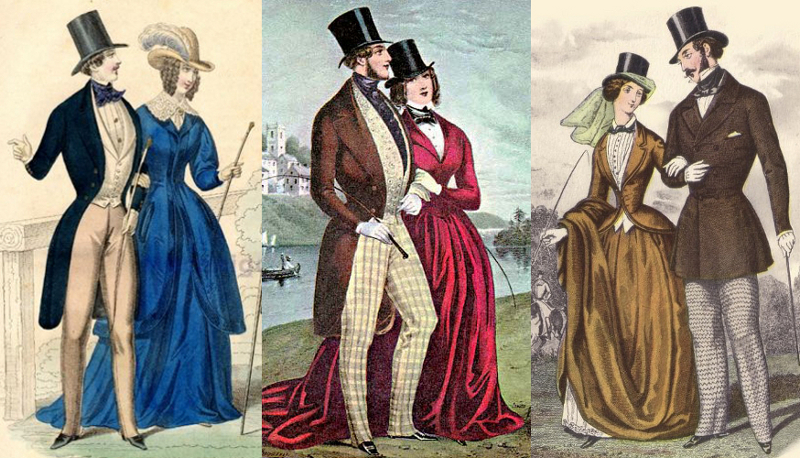
Victorian couples in riding attire, 1840 and 1850s. Most men’s outfits were made for riding.
Mankind’s love of horses is older than recorded time and continues today. Nothing compares to a gallop; your mount gliding swift and even, barely making contact with the ground, rider and steed as one, practically on wings. Early in the 1800s the male wardrobe was entirely designed around travel in a saddle. As the century wore on, infrastructure throughout Britain improved, people started to journey more by carriage, train, and finally automobiles. The clothing reflected this trend, but overall, most men could climb on a horse anytime, whatever they were wearing, and ride comfortably. Of course there were exceptions, like formal wear, court dress, &c., but even those outfits only required the addition of a decent pair of boots. This option wasn’t true for women.
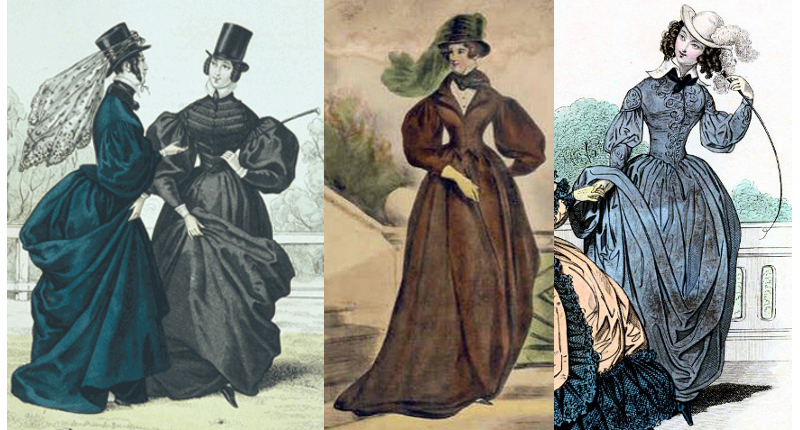
Riding habits from the 1830s. Gigot sleeves were obviously popular, and the toppers look very much like men’s hats. Two of the jackets end basically straight at the waists. Three ladies carry their skirts gathered, and the girl on the right may have dark blue trousers on.
The Victorian’s adored horses and wealthy ladies often rode daily, for travel, exercise, pleasure, and hunting. Due to their lavish wardrobes, the styles and expense, riding habits were crafted specifically for equestrian pursuits. This wasn’t a new fashion trend, but previously only a small portion of ladies rode recreationally, while during the 1800s the upper and middle-classes grew considerably, and with them thousands of fashion-conscious females with a desire to ride and be seen riding. The word ‘habit’ comes from the old French abit, meaning clothing, and originally referred to ecclesiastical attire, but came to mean any outfit for a specific purpose. Riding habits have always taken cues from male dress through the centuries, and examining examples from Victorian times doesn’t veer from the practice.
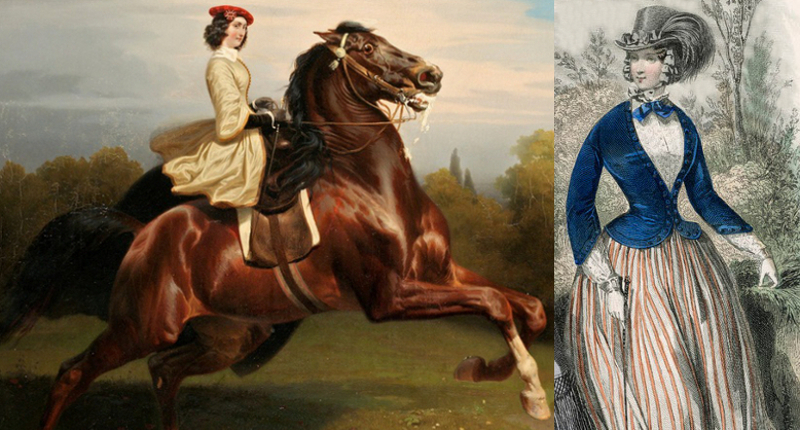
A couple country riding habits from the 1850s. The mounted girl wears quite a long light tan coat with flared sleeves, black under-sleeves, and black skirt, a jaunty red tam. The dismounted lady has a stylish topper with a plume and ribbon chinstrap, and perhaps a velvet jacket and silk or cotton striped skirt.
It should be noted, some habits were casual (for country hacking, visiting friends, &c.), some were formal (for fox hunts, riding London’s parks, &c.), and some were in between. This held true for men and their various suits. An estate habit could be informal and have jackets and skirts of different fabric and colours, an ‘in town’ habit would match as a suit. A pair of leather gauntlets were fine for the country, but only kidskin would do in the city. Most fashion plates show women wearing beige or white gloves, which would be kidskin in natural colour or bleached. This leather is made from the hide of a young goat and is soft and stretchy, also known as wash-leather or chamois (although the latter is actually an antelope). Women also wore snug tailored wash-leather drawers for riding.
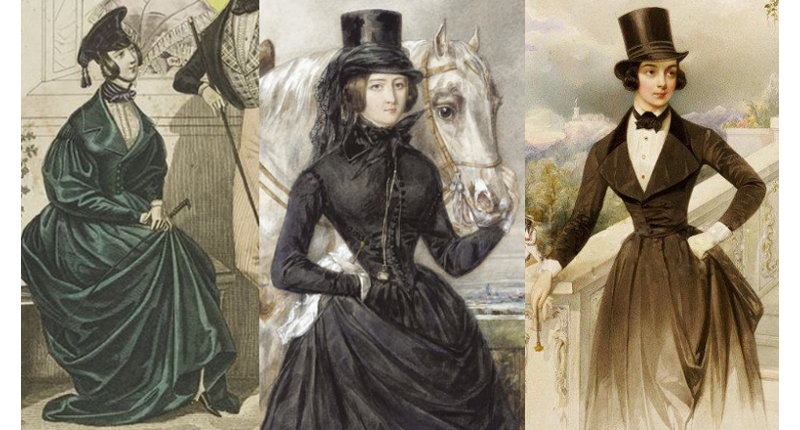
Riding habits from 1840, 1842, and late 1840s, revealing a variety of formal hats. The jackets basically end at the waist with the centre example having a point. Sleeves swung from gigot to fitted. The green habit seems to show an off-white trouser leg coming down over the lady’s boot, but might be a gaiter.
While there were different styles of habits, they had certain defining features. The skirts were generally a third longer than a normal hem length, to provide a long drape. Sewn into the front was a loop for a lady to slip around her boot by the outside stirrup, keeping the skirt from flying up, and there are also examples of skirts with weights sewn into the bottom hems. Sometimes near the trailing edge of the skirt was another loop to wear around the wrist or onto a button after dismounting, to ease walking with all the voluminous material. If there wasn’t a carrying loop the ladies would gather the skirt and hold it over an arm. The skirt could trail after getting to relatively clean pavement, gravel, cobblestones, &c. Skirts usually had at least one hidden pocket sewn in for a handkerchief. In 1885, snap fasteners were invented, and shortly after that a form of safety skirt for riding that would tear open along the line of snaps if a lady fell. In Edwardian times an apron-style skirt was offered with much less material which would be buttoned closed when dismounting.
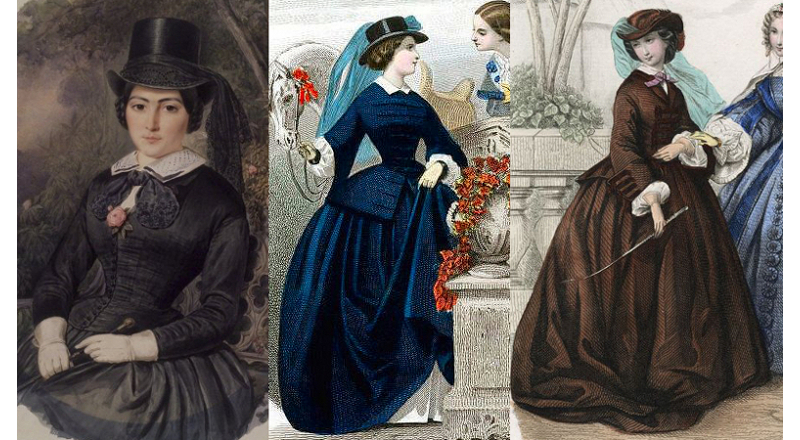
Riding habits from 1855, 1857, and 1859. This period was influenced by the Crimean War (1853-56), and military cues are clear in the trim of the blue and brown habits, and smaller or no lapels.
The jackets were tailored tight and normally looser in the sleeves to allow control of the reins. The styles somewhat followed fashion decade by decade, with lappets and peplums covering the hips coming and going, along with flared and gigot sleeves. Lapels went wide, narrow, and vanished altogether with military stock collars. Military influences remained a constant, women asking for soutache and galloon trim.
Habits were commonly dark coloured, to hide the dirt that naturally goes with riding, but light colours were used for summer. The best winter habits were made of very expensive velvet, usually of deep dark colours. Velveteen (cotton), developed in the late 1700s, could be used to produce a habit that looked like velvet, but was not as warm. Felted wool was the choice of most women; warm and practical. The quality of the wool, depth of the colour, and skill of the tailor determined the value. Expensive summer habits were made of silk, with yards and yards of pleated skirting. As cotton manufacturing progressed (and sateen was developed) less costly warm weather habits were made that looked like silk.
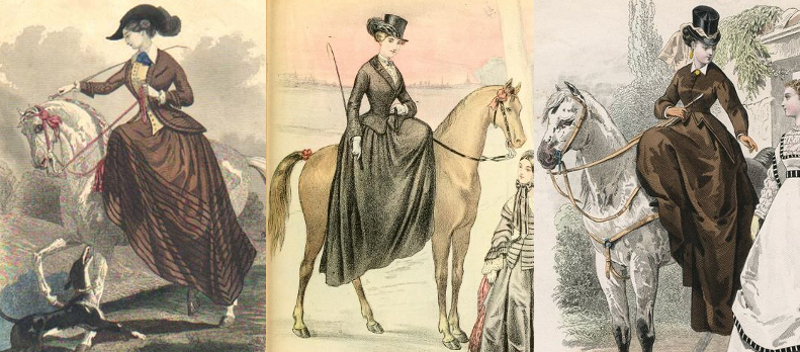
On the left, a lady on a country ride, 1840s. In the centre, a lady riding off side, 1853. To the right, a fashion plate from 1867.
Before the late 1850s the dyes were all natural and added to the cost. Post 1860 saw the use of chemical dyes (first developed in 1856) and made strong colours affordable. Velveteen and sateen was considered inelegant by the upper-crust of British society up until about the 1860s or 70s, when the fabrics met greater acceptance with the growing upper and middle-classes. “One was a lady, attired in an elegant, blue, velveteen riding-habit, with hat and feather to match, and with silky brown hair falling over her shoulders down to her horse’s croup.” Brighter Britain by W.D. Hay, London 1882. However, many individuals at the top of society insisted on silk fabrics (satin and velvet), and looked down their noses at anything cotton. We see it still today, with those who desire silk spending much more on undergarments, gowns, shirts, ties, suits, &c., than those satisfied with cotton or synthetic fabrics.
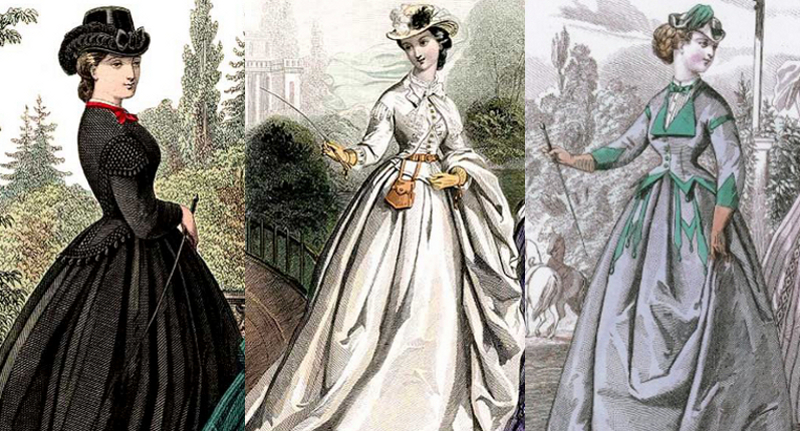
Riding habits from the 1860s, and two showing a taste for lighter colours. The lady in centre carries her skirt draped over her arm and has an interesting little reticule hanging from her belt. On the right, the green revers and trim would have been quite bold, and she wears a small hat that definitely would have required a pin, .
Hats for casual hacking were often wide-brimmed to keep the sun off a lady’s perfect pale complexion. Some equestrian headdresses included a chin strap (which could alternatively be tied under the hair), but they were seldom shown in paintings or fashion plates. At the start of Victoria’s reign, top hats and military styled peaked hats were popular for in town or fox hunting, but by the early 1840s toppers took over. These high hats might be plain in shape, or swoop-brimmed, and tapered or flare-crowned. The ladies’ toppers frequently followed the male fashion trends. The hats fit around the head (worn firmly in place) until the late 1860s or so, when women started favouring smaller headdresses perched forward and secured with a hatpin. What about sunburns? A sheer veil would be worn with the hats to filter the sun, and catch any clods of mud thrown up during a gallop. When a lady dismounted she would merely raise her veil and have a clean face for the post-hunt libation, conversation, and perhaps flirting. Late in the 1800s women started wearing bowlers with their habits. Bowlers were first made in 1849 as a hard hat for gamekeepers to wear.
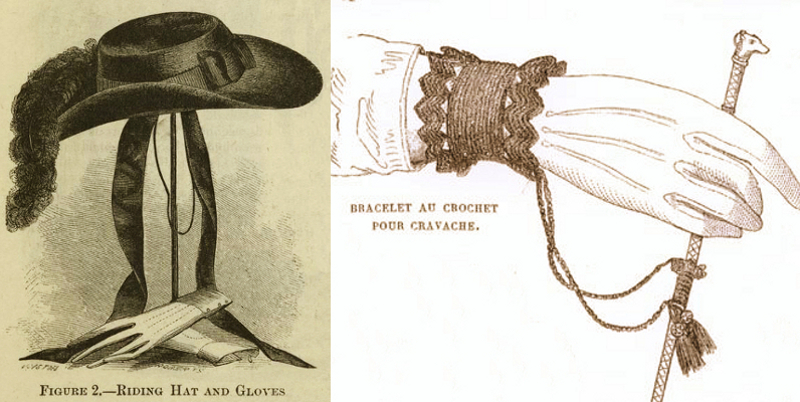
Ladies’ riding accessories, on the left from 1855, a cavalier style hat with chinstrap and ribbon. The crocheted bracelet for a riding crop, whip, or cane, would have served nicely and been more elegant than just a strap.
Riding pants were worn by women under their habit skirts at least as early as the 1830s. These trousers were crafted long and (like male pants at the time) covered the legs completely, held down with a buttoned strap or elastic under the waist (the part betwixt the heel and sole) of their boots. Examples of breeches also exist, which ended just below the knees. When riding pants started to be explicitly included as part of a habit I couldn’t determine, but museums have matching sets (jacket, skirt, and trousers) in their collections from the 1880s and on. Any habit made from 1890 and later that had a safety skirt included breeches, as a thrown lady might lose her skirt entirely. Early examples of side-saddle breeches, with the leg buttons on the outside of the left leg and inside of the right leg, date from the 1850s. Along with the habit a lady could purchase corsets, shirts, waistcoats, boots, hats, and accessories, all made specifically for riding. If you examine the pictures in this article you will see examples of whips and canes. Whips were for in town circumstances, while canes were for the countryside; the crook being used for opening gates between pastures without dismounting.
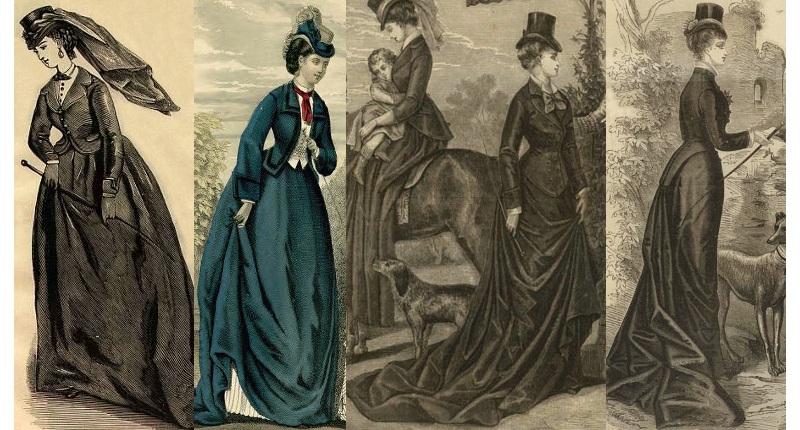
Riding habits from 1871, 1872, 1876, and 1878. The hats are worn forward on the heads. The open jacket with waistcoat in the colour fashion plate is interesting, and may well have been a false waistcoat as part of the jacket.
Of course women rode side-saddle, and were almost always depicted riding on the near side (with their legs to the left). However, saddles were also crafted with the horns to the far side (right) so a lady could alternate day after day. Horses were specifically trained to accept left and right side-saddles, and for mounting on the right hand side. Alexandra of Denmark (1844 – 1925), the consort of Edward VII, always rode on the off side due to a hip problem. The standard of mounting on the left side is because in a right hand dominant world, men wore their swords hanging from their left hips. Cavalrymen wore their sabres and sabretaches (a leather case or pocket) hanging on the left. It made sense to train horses for left side mounting, but it wasn’t a hard and fast rule. This mounting on the left influenced early motorcycle design, echoes of which carry on today.
Interestingly, in the 1600s it was perfectly acceptable for women to ride astride, and their outfits included trousers, and petticoats that unbuttoned up the front and back. Through the 1700s a lady straddling a horse grew less acceptable, and by the Regency era any woman riding astride was considered a hoyden and of questionable moral character. This would happen again as girls started riding bicycles in the late Victorian era. Jumping while riding side-saddle is no more dangerous than jumping astride; a woman’s legs are secure when she bends them around the fixed head (top) and leaping head (lower) pommels.
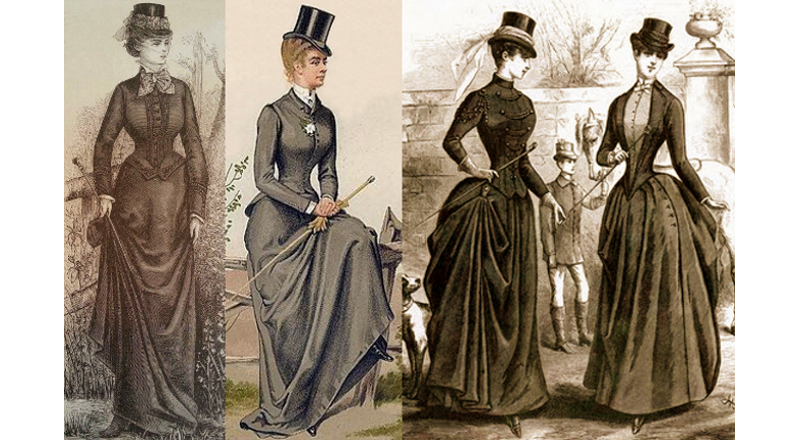
Riding habits from 1880, 1884, and 1886. The toppers are all small and worn perched on the heads. The two ladies on the right have their skirts buttoned up for walking, and shows military trim on one jacket, a false waistcoat on the other.
Exorbitant sums were paid for beautiful horses. It was during the Victorian era that so many breeds were named and categorized. Many women may have opted for pony breeds day-to-day, but hot-bloods built to jump were the most popular for hunters. Thoroughbreds fetched the largest sums, and were a breed developed in England during the 17th and 18th centuries when native horses were crossed with ‘Oriental’ stallions. A Thoroughbred foal must be able to trace its line back to three original studs. Pony breeds are less than 14 and 1/2 hands at the shoulder (58”/146 cm). A hand is four inches. Hot-bloods are bred for speed and agility with long legs and slim build. Cold-bloods are the draught horses, usually 16 to 19 hands at the shoulder (64”/162.5 cm to 76”/193 cm) with quiet temperaments. Warm-bloods were a cross between the hot-bloods and cold-bloods resulting in taller, stronger horses, with quieter dispositions than hot-bloods, and are now recognized breeds.
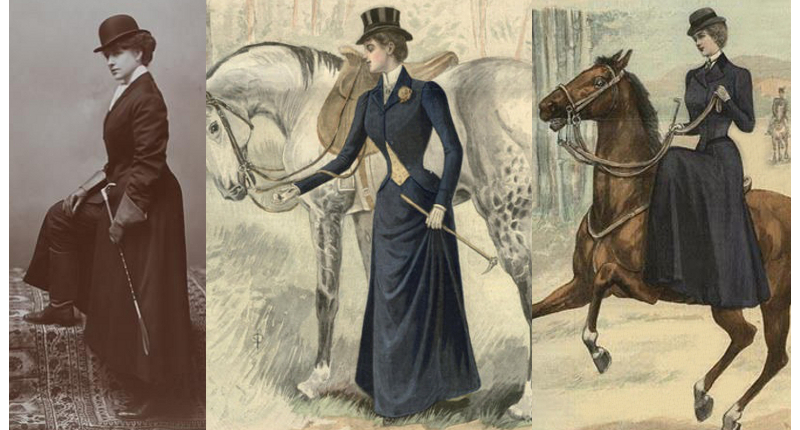
Riding habits from 1895, 1898, and 1900. Bowler hats had become acceptable. The photo is interesting as it shows the woman’s trousers and boots. If the lady at centre is of average height for the time (about 60”/152.5 cm) then her mount would be a pony breed.
A huge part of the Victorian calendar included horse competitions. Newmarket Racecourse in Suffolk was and is considered the home of British horse racing, with meets going back to the reign of James I (1566 – 1625). Epsom Downs in Surrey is almost as old, with records showing contests as early as 1625 when one of the competitors fell and broke his neck. Ascot Racecourse might be the most famous, founded by Queen Anne in 1711, associated closely with the Royal Family, and located near Windsor Castle. Originally a four day event (now five days) was held annually in June leading up the the Saturday nearest the summer solstice (Midsummer) and is known as the Royal Ascot. This was an important part of a débutantes presentation season, and included balls and other social events. To be invited to attend the races from the Royal Enclosure was considered an outstanding opportunity to catch the eye of a high-born suitor.
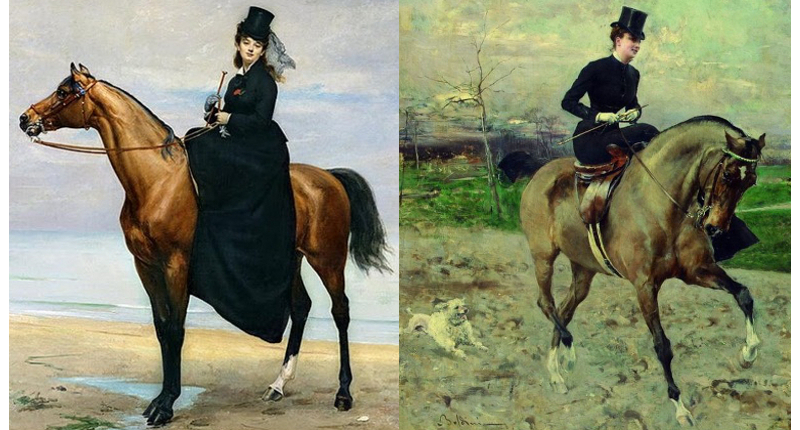
Formal riding habits from 1873 and 1880.
We hope you enjoy the articles and short stories presented here, and will join Kate in her adventures for many years to come.
Upon request, you will receive an inscribed copy of Kate Tattersall Adventures in China with every donation of $10 or more plus shipping. Please use the Contact Page to provide your shipping address and we will reply with your total.

Inge
What great outfits. How elegant! Thanks for this. Please do an article on saddles and tack.
L. Perkins
Did men and women have different riding crops during the Regency era? Could you tell which was made for a man or woman?
R.S. Fleming
@ L. Perkins, women used whips and canes that were more delicate and of finer construction than those used by men, with thinner shafts and handles. However, the canes had to be fairly hardy for pulling open gates, and were used in the country. Certainly, some of the riding aids would have been suitable for both sexes.
Justyna
beautiful and elegant! what a pleasure to read about those times…
Anastasia
Saved as a favorite, I like your site!
Karen M Fox
Great information and research! I am wondering at which point did riding habit skirts shift from one third longer to a side train? I am guessing as fashion moved from full hoops to bustles?
R.S. Fleming
Hi Karen, the hoops and bustles didn’t have much of an impact on habit styling, because hoops were never worn with habits, and only small cushion bustles. Safety was a greater factor, with the long full trains abandoned due to dragging deaths, and the development of tear-away and apron style side train skirts, both worn with breeches.
Carla
Just amazing some of the styles. We are actually in the equestrian trade and it’s amazing how some of the styles or at least fleating glimpses of what was worn in the past is still apparent. Who knows, maybe what is old will be new again!
Barbara
Did the Southern Belles actually wear hoop cages on their horse or just for the photographs? Their skirts still look very full!
R.S. Fleming
Barbara, the skirts were very full, with lots of material, but hoops weren’t worn. Petticoats and a pillow bustle were common. There might be some rare circumstances when a lady wore hoops while riding, but this would have been extremely awkward, dangerous, and probably embarrassing as anyone on foot could have looked up under the skirting.
Anthony
It’s interesting looking at these old images. Believe it or not here in Australia side saddle is making a comeback. In some competitions they are judged right down to the outfits they wear.
Magpie
What a terrifically informative article! I don’t suppose you have a bibliography? I’m going to be making an early 1860’s habit, and I’d like to get more info on fabrics. 🙂
R.S. Fleming
Hi Magpie, winter habits were crafted of velvet or wool, summer habits were silk or cotton made to look like silk. Linings were often of linen or canvas. If you have specific questions you can send me a note through the contact page.
Royaline Sing
Very nice and pretty pictures. Interestingly there is no mention of Jodhpurs. When did they get popular? The 1895 habit is very interesting. So having the trousers visible was acceptable at the time? Saved the site, really like the article.
R.S. Fleming
Jodhpur breeches was a style of riding trousers that grew in popularity at the end of the 1800s. They were developed in Jodhpur, India, and brought by the British to Europe. When people speak of jodhpurs today, we envision riding pants that are full at the hips and thighs, then tight from the knees to the ankles, or a pair of ankle-high boots with a strap at the ankle (also developed in India).
Lady in Waiting
Great article. I’m in the process of designing a late 19th century women’s riding habit, but there is little information about the undergarments. Did women ditch the corsets or was it still a requirement when riding?
R.S. Fleming
Corsets were worn, but it wasn’t a requirement. It was their foundation garment, and to not wear a corset would be similar to a woman riding today without a bra, so it would depend on physique. The waistcoats worn under the habits could provide some support, and the jackets were often cut tight. By the late 1800s corsets were more elastic, providing freer movement.
Hi
Nice work
emma
a great article about the riding habits.
michele kelley
Fantastic, really enjoyed reading the questions and answers, very useful indeed. Thank you
Juliana
Very interesting article! The best I’ve found about this subject.
Elaine M. Hoffman
Your website was about the only one on the Internet anywhere near the information that I am trying to research. I plan to create an Equestrian habit for my American Girl doll with a top hat with tulle, a crop, gloves, Gigot sleeves on the blazer jacket, long skirt, but maybe splitting the skirt to make long cullots for easy riding? It is very hard to pose an American girl doll side saddle on a horse. What kind of shoes did they wear back then? I only saw one image with boots because her skirt was split and she exposed her trousers underneath the skirt. I also like that idea. Was it Victorian high top boots, (hope so) or Equestrian riding boots?
R.S. Fleming
Hi Elaine, sounds like a very interesting project. I haven’t found firm evidence of women wearing topboots, but they definitely wore knee-high riding boots in black and brown in Wellington and Hessian styles. In regards to the skirt, it would depend on the decade. I hope that helps.
Nicola Rochford
This is so informative. I would like to have a go in Concours d’ Elegance this year (if we can ever do anything ever again!). I want to have a go at making my own costume, Forrest/bottle green velvet would be heaven for me. Do you know if there is somewhere to buy a pattern from? Thanks again for a great read.
R.S. Fleming
Hi Nicola, which decade are you thinking of replicating?
Claudia
Love—Love—Love this page